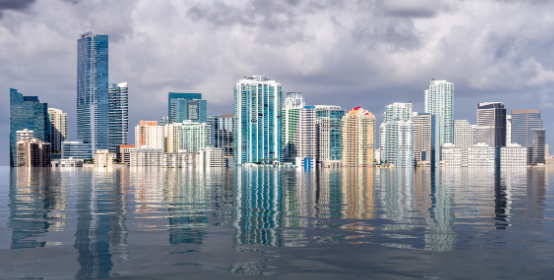
Scientists have raised the alarm about populated areas imperiled by rising coastlines, but that isn't the only threat to cities around the world. The increasing demand for water is triggering another phenomenon that's equally dangerous: subsidence.
Subsidence describes a situation in which land sinks, taking everything on top of it with it. This isn't necessarily as dramatic as a sudden sinkhole, either—subsidence can be deceptive and gradual. It also means that coastal areas can be even more severely impacted than they would be by rising sea levels alone. Fortunately, there are ways to help halt subsidence and protect these cities:
In 1968, Tokyo's subsidence peaked at 9 inches per year. This was largely due to groundwater extraction. Officials passed laws limiting pumping, which helped decrease subsidence to less than half an inch per year.
There's only one problem with this—it requires an alternate source of water, which can be a major feat of civil engineering. During the 1970s-80s, Japan invested heavily in water resource development. The country identified areas that were growing and would need increased access to water, then built dams to create more storage areas. Tokyo now gets the majority of its water from local rivers, and its tap water is considered very high quality.
Unfortunately, not every area has the ability to switch water sources. In this part of Virginia located in the south Chesapeake Bay region, groundwater pumping is the biggest contributor to subsidence. It's a major problem, too, as the area's location in the bay region means that its aquifers are prone to saltwater intrusion.
Unlike with Tokyo's situation, civil engineers aren't able to build dams and shift the population away from the consumption of groundwater. Instead, water engineers have come up with a different solution: recharge the aquifers with treated wastewater. This project, named Swift, involves treating wastewater until it meets the same standards as drinking water. This now-clean water will then be pumped back into the aquifer. If this project works, it will offset the over two feet of subsidence experts expect to occur over the next 50 years.
Not all subsidence is due to water usage. Some of it part of a long process of substrate compaction, the flow of fluid lava, the dissolution of minerals by groundwater, and even just tectonic deformation. There isn't much that engineers can do about these forces, but architects can plan around them.
There are multiple ways to help plan cities around subsidence. The biggest threat post by sinking cities is flooding. Sea walls, like the Giant Sea Wall Jakarta project in Indonesia, can help hold back rising tides and shield cities. Building structures on stilts is another way to help protect buildings from flooding.
Another thing to remember is the importance of bedrock. Bedrock is stable and won't subside from the loss of groundwater. If the foundations of large buildings are anchored on bedrock, they'll remain in place even if the soil around them subsides. From an engineering perspective, it's important for large buildings to have deep foundations so soil remains uncompressed and there is sufficient space left for rain to infiltrate and reduce sinking.
Part of the problem with flooding is that it typically isn't constant. If it was, it wouldn't be flooding anymore, it'd just be a new coastline. Planning urban areas with structures that both serve the needs of the community and help manage flood waters may prove to be a crucial part of designing and maintaining modern cities.
Imagine a traffic tunnel that can be shut down to traffic and used to divert flood waters, or parks created with artificial wetlands and water storage areas. While this won't prevent subsidence itself, civil engineers can use these structures as needed parts of regular urban planning and utilize them to protect people against the effects of subsidence.
A big part of the problem with groundwater pumping is that it isn't replenished as fast as it's used up. This is why some areas need to turn to means of artificially recharging their aquifers. Good civil engineering and urban design can help here.
Paved areas are a big problem when it comes to water management. This is because they're impermeable—when water can infiltrate them, it causes potholes and cracks. That means that water hits pavement and has to be directed somewhere else, instead of sinking into the ground where it falls. Engineering cities with abundant green spaces and more permeable materials can help offset some of the loss of groundwater by allowing rain to replenish it.
The ground is moving, and a lot of that has to do with the ways that we use and manage our water. By shifting to sources other than groundwater, replenishing aquifers, and designing urban areas with future flooding in mind, civil, water, and structural engineers can help protect people against the impact of subsidence.